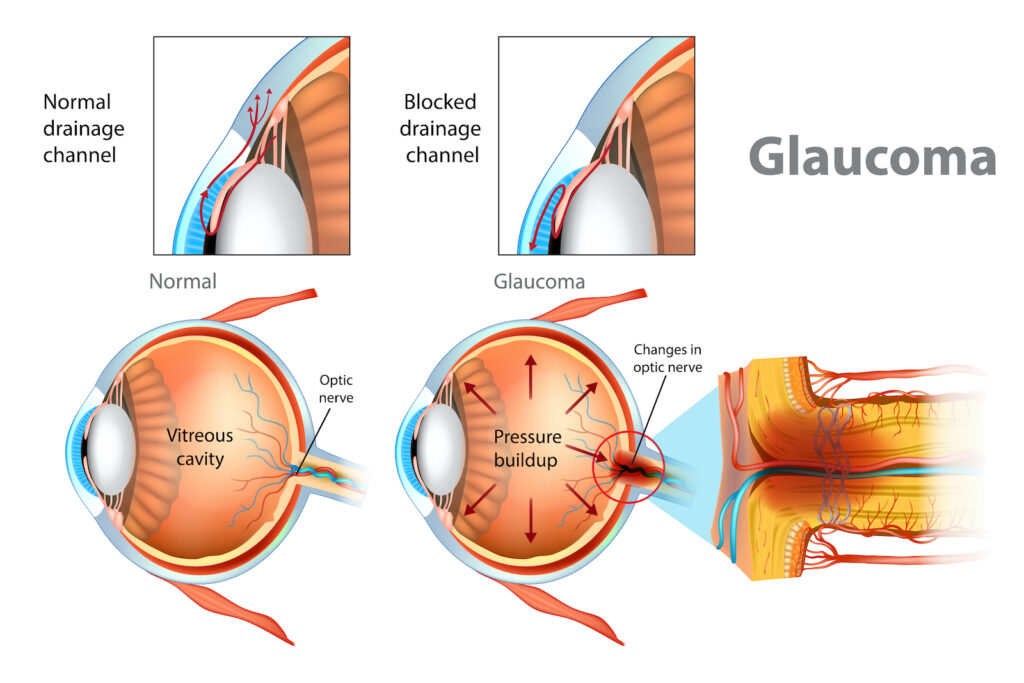Glaucoma Evaluation and Treatment

What is Glaucoma?
The nerve fibers within the optic nerve send information to the brain to process what you see. Glaucoma is an eye disease that interrupts this process by damaging the optic nerve, which may result in a permanent loss of vision.
Causes
Glaucoma is caused by increased pressure within the eye. When the eye’s fluid (aqueous fluid) cannot drain properly, the pressure increases, which, in turn, presses on the optic nerve. There are approximately 20 different types of glaucoma, the most common being open-angle glaucoma and narrow-angle glaucoma. The cause of vision loss with glaucoma is optic nerve damage.
Symptoms
Symptoms vary from person to person and by the type of glaucoma. There are usually no early warning symptoms with open-angle glaucoma, the most common form of the disease. Regular eye exams are important to detect early glaucoma. Vision loss may not be noticeable until the disease has progressed further.
With narrow-angle glaucoma, symptoms may include blurred vision, headaches, eye pain, sensitivity to light, nausea, vomiting and halos around lights. Vision loss is not noticeable until the disease has progressed and it is too late.

Glaucoma Prevention
Because glaucoma may not initially display any symptoms, the best form of prevention is regular eye exams.
Treatment Options
After diagnosis, you and your doctor will discuss which treatment option is best suited for your needs. All current treatments for glaucoma are designed to reduce the amount of pressure within the eye. Some of the more common treatment options available are prescription eye drops and/or laser surgery. Your doctor may prescribe eye drops to treat open-angle glaucoma. It is usually necessary to use these drops one or more times per day. Your eye doctor or surgeon may recommend a laser procedure to either open another drainage channel (for narrow-angle glaucoma) or aid in the drainage of fluid (for open-angle glaucoma) to lower intraocular pressure.
At Scott & Christie Eyecare Associates, our doctors perform an FDA-approved laser treatments known as Selective Laser Trabeculoplasty (SLT) for open-angle glaucoma and Laser Peripheral Iridotomy (LPI) for narrow-angle glaucoma.
Selective Laser Trabeculoplasty
The SLT option may eliminate the need for eye drops. The treatment is usually effective for 2-5 years. SLT is a cool, non-thermal laser treatment and can be repeated if your pressure increases later.
Laser Peripheral Iridotomy
The LPI procedure involves creating a tiny opening in the peripheral iris (the colored part of the eye). This allows the eye’s aqueous fluid to flow from behind the iris directly into the anterior chamber, thereby eliminating the risk of angle closure.
Both the SLT and LPI laser treatments are performed on an outpatient basis with only topical anesthetic drops, and are usually painless procedures.
Learn the Risks and Benefits of Glaucoma Treatments
Before considering any of the outlined treatment options, it is important to understand the risks and benefits associated with them.
For the eye drops, patients may experience temporary symptoms, such as itchiness or stinging, redness, dry mouth, headaches or blurred vision. Never stop taking or change eye drop medications without talking to your doctor.
There are risks for laser surgery, the most common being minor bleeding.
Benefits of receiving either treatment option include prevention of further damage to the optic nerve.

Did You Know?
Glaucoma is a leading cause of unnecessary blindness in the United States.
Everyone has the potential to develop glaucoma. However, some groups of people have a higher risk of developing the disease than others because it is a hereditary condition. If there is a family history of glaucoma, you should be checked for glaucoma yearly.





